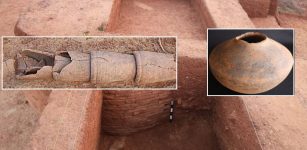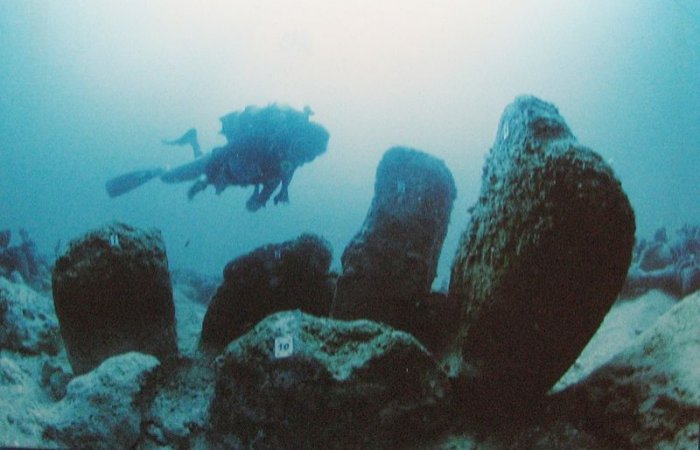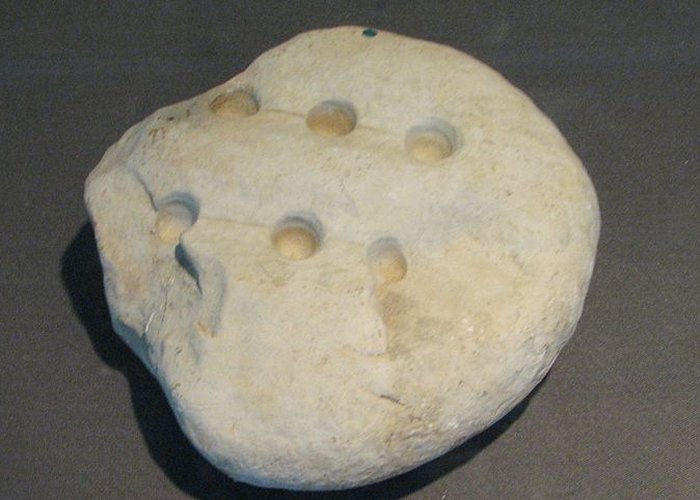Atlit Yam – Fate Of The 9,000-Year-Old Underwater Megalithic Site With A Huge Stone Circle
Jan Bartek - AncientPages.com - About 9,000 years ago, long before Stonehenge in the UK was constructed, a Neolithic society in Israel built a large stone circle using heavy megaliths. This ancient structure is now submerged, but what was its purpose?
Atlit Yam is an ancient submerged Neolithic village off the coast of Atlit, Israel. Credit: Hanay - CC BY-SA 3.0
Who were the inhabitants of the ancient underwater village, Atlit Yam? Why was their settlement flooded? What can we learn about these peoples' beliefs, traditions, and daily life from underwater surveys?
Who Were The People Living In Atlit Yam?
Atlit Yam is a Pre-Pottery Neolithic settlement submerged off the Carmel coast of Israel. Atlit Yam is an important archaeological place because the well-preserved finds at the site have provided scientists with helpful information about the burial practices of the Pre-Pottery Neolithic society. This is a subject researchers possessed little knowledge about before discovering Atlit Yam.
Many experts have examined the underwater remains of Atlit Yam, and the site has been carbon-dated to be between 9,000 and 8,300 years old.
Underwater archaeologists have discovered remains of rectangular houses, hearth-places, botanical remains, stone, and flint tools, as well as many well-preserved human remains resting beneath the water.
Based on the archaeological findings, scientists suggest Atlit Yam was a fishing village. The discovery of piles of fish ready for trade or storage indicates inhabitants of the Neolithic village suddenly abandoned their homes. Unfortunately, it seems not everyone managed to escape the natural disaster that destroyed Atlit Yam.
Game carved of limestone played by people living in Atlit Yam. Credit: Photography by Yosef Galili, Ehud Galili, Itamar Greenberg - CC BY-SA 3.0
Atlit Yam's "economy was based on integrated subsistence components, including terrestrial and marine resources – the so-called agro-pastoralmarine Mediterranean fishing village." 1
When examining the human skeleton belonging to both adults and children, scientists discovered 46 locations characterized as actual graves.
"Two burials contained three individuals each, 11 burials contained two individuals and 33 burials contained a single individual.
Most graves (71 percent) were shallow pits dug into the clay. None of these graves showed evidence of stone construction or surface marking." 1
Further examination of the underwater site revealed people living in the Atlit Yam village, sometimes referred to as the earliest-known agro-pastoral fishing community, often buried their dead in the vicinity of their house or even within the dwelling.
This "strongly suggests that even after death, an individual was still considered a member of the household." 2
Many people were buried in a flexed position on their sides or backs, which indicates the Atlit Yam people followed specific ritualistic burial customs unknown to scientists.
Scientists discovered "a number of skeletons exhibit signs of disease and health problems possibly caused by dietary or other environmental factors. For example, tuberculosis and arthritis were common, as are indications of infectious diseases, including those causing high fevers during childhood. Occasional bone breaks and cracks suggest traumatic injury as well." 2
Underwater archaeologists also discovered "stone foundations of several rectangular structures, paved floors, long straight walls, hearths, round megalithic structures, storage and production installation and water wells." All these submerged structures are embedded in dark clay.
Atlit Yam's Megaliths
Researchers examined Atlit Yam's megalithic installations and suggested these structures were used for certain rituals.
An artist's reconstruction of the Atlit Yam's large stone circle was looked like. Credit: Photography by Yosef Galili, Ehud Galili, Itamar Greenberg - CC BY-SA 3.0
The ritual installation of megaliths, "consists of seven stones (1-2.1 m long), six of which are still standing upright, forming a circle (diameter ca. 2.5 m) open to the northwest. The bases of the standing stones are covered with gray travertine attesting to the presence of fresh water in the past. Close to the standing stones to the west, a few flat stone slabs (0.7-1.2 m long) were found lying horizontally. On some of them were hewn shallow cup-marks.
It is suggested that these features formed part of a ritual structure, perhaps associated with a fresh-water spring that may have existed at the site. Another installation consists of three oval stones (1.6-1.8 m), two of which are circumscribed by grooves forming schematic anthropomorphic figures." 3
The End Of Atlit Yam
Sadly, the inhabitants of Atlit Yam, who relied on the sea in their daily life lived in a place that was not meant to survive. It is unknown how many people lived in the village at the time, but though it seems the village was abandoned before the natural catastrophe, some people may have still have perished when the waves covered the Neolithic settlement
"While the sea contributed to the prosperity and success of the community it may in the end, have been a major factor in the village's abandonment. At the time the village was lived in, the sea level was lower, and the coastline was about 1,000 feet to the west of the settlement. This lower sea level (about 45 feet below the present sea level) was the result of huge quantities of water being trapped in the glaciers much farther to the north.
Toward the end of the Pleistocene and beginning of the Holocene, as the glaciers began melting, sea levels began to rise slowly. At some point, with the encroachment of the sea, the shore was so close to the village that coastal dunes covered the area and continued habitation was no longer possible. Following abandonment, the village was submerged." 2
There are many interesting underwater archaeological sites along the Israeli coast, including Atlit Yam.
Updated on November 16, 2024
Written by Jan Bartek - AncientPages.com Staff Writer
Copyright © AncientPages.com All rights reserved. This material may not be published, broadcast, rewritten or redistributed in whole or part without the express written permission of AncientPages.com
Expand for references- Galili, E., Gopher, A., Eshed, V., & Hershkovitz, I. (2005). Burial Practices at the Submerged Pre-Pottery Neolithic C Site of Atlit-Yam, Northern Coast of Israel. Bulletin of the American Schools of Oriental Research,(339), 1-19.
- Galili, Ehud, Daniel Kaufman, and Mina Weinstein-Evron. "8,000 Years Under the Sea." Archaeology41, no. 1 (1988): 66-67.
- Israel Antiquities Authority - The Pre-Pottery Neolithic Site of Atlit-Yam
- Wikipedia - Atlit Yam
More From Ancient Pages
-
 Ancient Race Of Star Worshippers And Secret Message Stored In Unusual Monument
Ancient Mysteries | Jun 11, 2018
Ancient Race Of Star Worshippers And Secret Message Stored In Unusual Monument
Ancient Mysteries | Jun 11, 2018 -
 Ancient Gymnasium Discovered In Egypt
Archaeology | Nov 6, 2017
Ancient Gymnasium Discovered In Egypt
Archaeology | Nov 6, 2017 -
 Who Has Stolen Charles Darwin’s Notebooks Worth Millions From The University Of Cambridge?
News | Nov 24, 2020
Who Has Stolen Charles Darwin’s Notebooks Worth Millions From The University Of Cambridge?
News | Nov 24, 2020 -
 Petronella Oortman And Her Giant Dolls’ House
Featured Stories | Jul 10, 2019
Petronella Oortman And Her Giant Dolls’ House
Featured Stories | Jul 10, 2019 -
 On This Day In History: Crew Of Discovery Launches Mutiny Against Captain Henry Hudson – On June 22, 1611
News | Jun 22, 2016
On This Day In History: Crew Of Discovery Launches Mutiny Against Captain Henry Hudson – On June 22, 1611
News | Jun 22, 2016 -
 On This Day In History: Moscow Armistice Signed Between Finland And Soviet Union – On Sep 19, 1944
News | Sep 19, 2016
On This Day In History: Moscow Armistice Signed Between Finland And Soviet Union – On Sep 19, 1944
News | Sep 19, 2016 -
 Germany’s Stonehenge Pömmelte Reveals More Secrets – 140 Wooden Houses And 78 Silos Found
Archaeology | Jul 2, 2024
Germany’s Stonehenge Pömmelte Reveals More Secrets – 140 Wooden Houses And 78 Silos Found
Archaeology | Jul 2, 2024 -
 Riddle Of The Ancient Lost City Beneath Missouri – A Puzzling Discovery
Civilizations | Mar 21, 2022
Riddle Of The Ancient Lost City Beneath Missouri – A Puzzling Discovery
Civilizations | Mar 21, 2022 -
 2,000-Year-Old Trade Center: Brick Structure, A Vishnu Sculpture Among Findings In Andhra Pradesh
Archaeology | Nov 6, 2019
2,000-Year-Old Trade Center: Brick Structure, A Vishnu Sculpture Among Findings In Andhra Pradesh
Archaeology | Nov 6, 2019 -
 The Oldest Denisovan Fossils Ever Discovered Shed New Light On Early Hominins As They Spread Across Eurasia
Archaeology | Nov 30, 2021
The Oldest Denisovan Fossils Ever Discovered Shed New Light On Early Hominins As They Spread Across Eurasia
Archaeology | Nov 30, 2021 -
 On This Day In History: Gottfried Wilhelm von Leibniz – Famous Philosopher, Scientist And Mathematician Died – On Nov 14, 1716
News | Nov 14, 2016
On This Day In History: Gottfried Wilhelm von Leibniz – Famous Philosopher, Scientist And Mathematician Died – On Nov 14, 1716
News | Nov 14, 2016 -
 Mythical Underground Labyrinth And Legendary Long-Lost Golden Tomb Found In Italy?
Featured Stories | Nov 21, 2024
Mythical Underground Labyrinth And Legendary Long-Lost Golden Tomb Found In Italy?
Featured Stories | Nov 21, 2024 -
 Mystery Of The Ancient Unknown Mining Civilization In North America – Puzzling Archaeological Discoveries – Part 1
Ancient Mysteries | Apr 18, 2022
Mystery Of The Ancient Unknown Mining Civilization In North America – Puzzling Archaeological Discoveries – Part 1
Ancient Mysteries | Apr 18, 2022 -
 10,000-Year-Old Adorned Female Infant Burial Discovered In European Cave
Archaeology | Dec 14, 2021
10,000-Year-Old Adorned Female Infant Burial Discovered In European Cave
Archaeology | Dec 14, 2021 -
 Bona Sforza – Ambitious Queen Of Poland Was Betrayed And Murdered
Featured Stories | Jan 21, 2019
Bona Sforza – Ambitious Queen Of Poland Was Betrayed And Murdered
Featured Stories | Jan 21, 2019 -
 Why Did Sages And Shamans Repeatedly Visit The Mysterious Finnish Pirunkirkko Cave (Devil’s Church)?
Archaeology | Nov 27, 2023
Why Did Sages And Shamans Repeatedly Visit The Mysterious Finnish Pirunkirkko Cave (Devil’s Church)?
Archaeology | Nov 27, 2023 -
 A Stone Age Child Buried With Bird Feathers, Plant Fibers And Fur Investigated In Finland
Archaeology | Nov 2, 2022
A Stone Age Child Buried With Bird Feathers, Plant Fibers And Fur Investigated In Finland
Archaeology | Nov 2, 2022 -
 Rare, Well-Preserved Medieval Bone Flute Found In Kent
Archaeology | Nov 24, 2022
Rare, Well-Preserved Medieval Bone Flute Found In Kent
Archaeology | Nov 24, 2022 -
 Cenomani People: Their Pre-Roman Celtic Cemetery Reveals Funerary Customs
Archaeology | Apr 18, 2019
Cenomani People: Their Pre-Roman Celtic Cemetery Reveals Funerary Customs
Archaeology | Apr 18, 2019 -
 Oldest Sea Reptile From Age Of Dinosaurs Found On A Remote Arctic Island
News | Apr 3, 2023
Oldest Sea Reptile From Age Of Dinosaurs Found On A Remote Arctic Island
News | Apr 3, 2023



